Editor of this issue: Thomas Remeikis
Copyright © 1980 LITUANUS Foundation, Inc.

|
LITUANUS
LITHUANIAN QUARTERLY JOURNAL OF ARTS AND SCIENCES
Volume 26, No.1 - Spring 1980
Editor of this issue: Thomas Remeikis ISSN 0024-5089
Copyright © 1980 LITUANUS Foundation, Inc. |

|
SCULPTOR ANTANAS BRAZDYS
Antanas Brazdys is an acclaimed artist, especially well known in England, where he has lived since 1961. Culturally and existentially he spans the continents: born in Lithuania, educated in the United States, and currently working in England.
Antanas Brazdys was born in Lithuania in 7939. At the end of World War II he and his family ended up in Germany as refugees. The family eventually moved from Germany to the United States. His father, an architect, and mother, an avid cultivator of the Lithuanian folk dance, must have had something to do with Antanas' predisposition toward art. In fact, later on, Brazdys has admitted this himself. Max Wykes-Joyce, writing in London's Arts Review (August 1,1978), cites Brazdys as saying: "It's strange, when I was a child my mother made me learn all those Lithuanian dances of hers, and I hated it. Now, form time to time, I see the sort of rhythms I learned then coming out in my handling of the metal, so I suppose nothing we ever learn is ever wasted."
Brazdys obtained his grounding in sculpture at the Art Institute of Chicago (1956-1961). His achievements in sculpture, shown in group exhibits in Chicago, earned him the Edward L. Reyerson grant for foreign travel and study. As a result, he ended up in London, in the Royal College of Art for study and part-time teaching.
Since moving to London, Brazdys has held three one-man shows, participated in a number of group exhibits, and won several important commissions for sculpture. He works with welded steel, which is highly polished in his latest works. Following the first one-man show in Hamilton Galleries, Denis Brown wrote about his debut (Arts Review, December 25, 1965):
Brazdys regards his symmetrical formation, as an organic structure - and he relates this structure to nature, with its many parallels to human beings, animals and organisms. But, while this frontal imagery is pre-decided, with the side-elevation, one is confronted by a completely new vista of decision . . .; this Brazdys claims is the vital aspect of his work. For whilst he recognises the element of classicism in his projects, he also feels for the realisation of ideas which pipe into them energy and shape: and organise his structures to epitomise the translation of this energy from one point to another.
Another critic, Charles S. Spencer, reviewing the exhibit in The New York Times (December 28, 7965, International Edition), made these predictive comments:
This exhibition, I feel sure, marks the beginning of what will be a major career. There is no question of Mr. Brazdys's debt to Lipshitz, whom he regards with veneration; there is a similar involvement with thick, tubular shapes, but whereas Lipshitz is given to complex, baroque designs, the younger man is far more selective and classically direct.
In comparison with the mechanical, cool imagery of the leading young British sculptors, Mr. Brazdys is frankly humanistic, part of a long European tradition, although he is by no means narrowly conservative either in his materials or the use he puts them to.
The human form is his starting point, but instead of a sentimental, anecdotal exploitation of the human situation, he pares down the human body, so to speak, to its very bones. "Marriage," for instance, his finest work to date, is basically two curved forms, one representing the vertebra, the other embracing arms or thighs. Painted black, these two simple shapes are linked by a series of small spherical shapes and the whole is a remarkable mixture of formal elegance and sexual involvement.
Mr. Brazdys works entirely in welded steel, and some of the smaller works are brilliantly polished. In this heavy, weighty material, and the chosen bulbous shapes, he never fails to give the impression of lightness, even gaiety, and if there is a potential flaw in his work it is precisely in this too easy decorativeness. His greatest virtue however is to show that within the European tradition, the inspiration for the human form, new and significant sculpture can be created.
His most recent one-man showing was at the Annely Juda Fine Art Gallery in London in 1971. Peter Fuller of the Arts Review summarized Brazdys' achievements in a capsule:
Brazdys works almost exclusively in stainless steel. What comes over clearly in all his works is an excitement about the material properties of this metal which he uses in a deliberately spectacular fashion, voluptuously and indulgently exploring its potentials. Every aspect is exploited, from reflective surfaces to structural adaptability. What is fascinating about all Brazdys' pieces is the extent to which he is prepared to gamble, taking what seem to be gargantuan risks in formal terms, and just getting away with it almost every time. The undulating tube that appears to be poised preposterously a moment before it crashes, entices us into the drama. The gleaming steel beguiles us. Brazdys' conscious, metallic wit delights us: To my friends who are struggling with the square, is a hallucinatingly effective example. Perhaps where one draws the line at collusion, is in his insistence on monumentality, his assertive belief in finite object dominance. There is a distinct imaginative limitation here which must be recognised. But within the terms he has laid down for himself, he practises sculpture to devastating effect.
Brazdys has executed a number of important commissions. Three deserve a special attention. He won The Sunday Times competition for young sculptors and was commissioned to produce a sculpture for the Woodgate House, London. The sculpture, entitled "Ritual," was completed in 7969. In 1970 he was commissioned to create the entrance feature for the British Pavilion, Expo 1970, Japan. In 1973 Brazdys executed a commission for Harlow New Town, England, entitled "Echo."
Brazdys latest public showing was in 1978, in a group exhibit arranged by the Harlow Art Trust. Since then he has been busy preparing for a major one-man exhibit in New York.
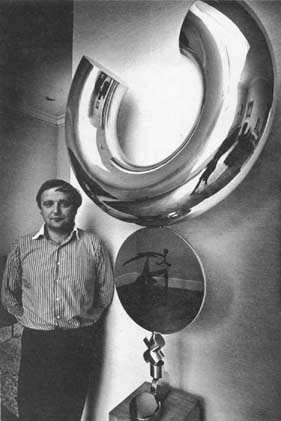
Antanas Brazdys besides his UNTITLED sculpture, 1971, stainless steel, 64" high
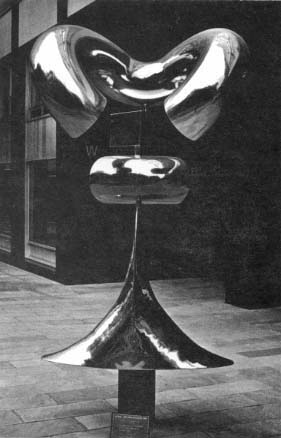
Antanas Brazdys, RITUAL, 1969, stainless steel, at Woodgate House, London
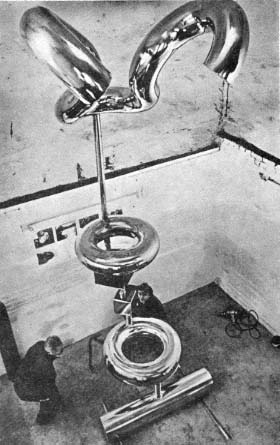
Antanas Brazdys, OSAKA sculpture, 1970, stainless steel
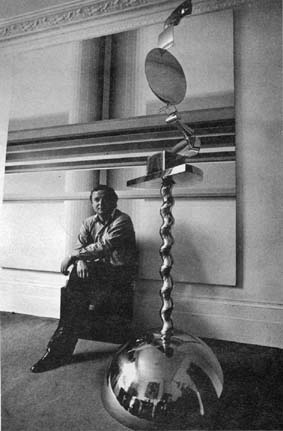
Antanas Brazdys with PIROUETTE, 1971, stainless steel, 100" high
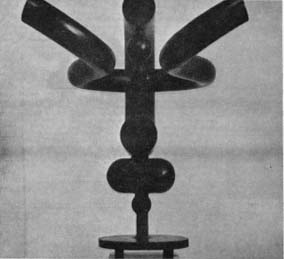
Antanas Brazdys, MARRIAGE, 1965, welded steel, 50" high
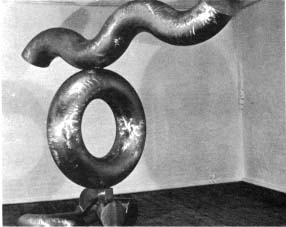
Antanas Brazdys, UNTITLED, 1971, stainless steel